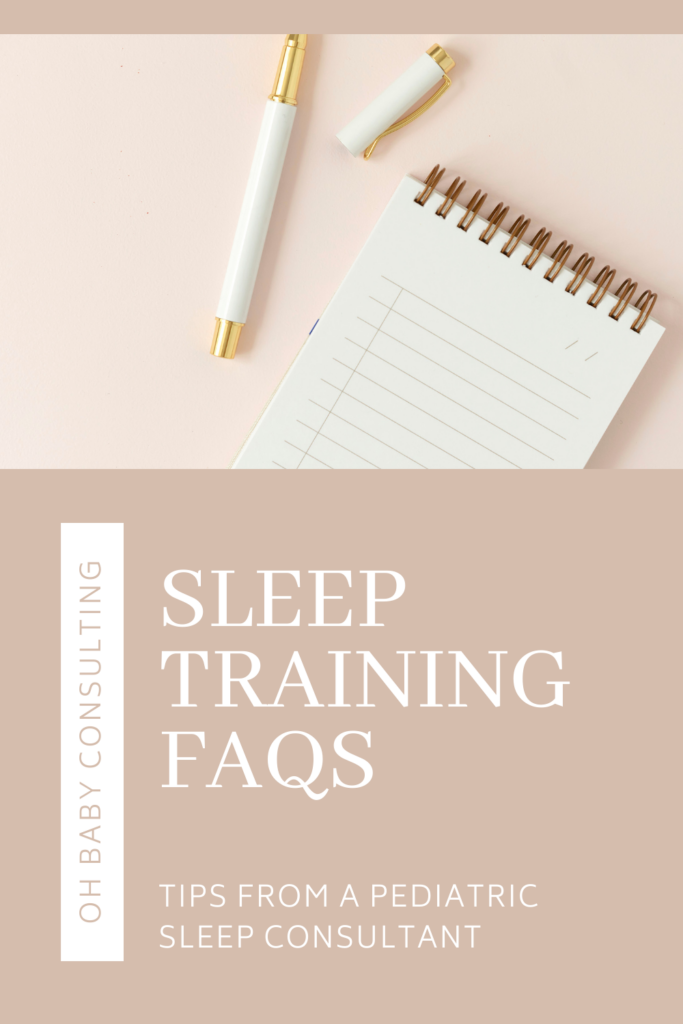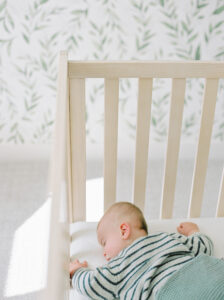Sleep training can be a daunting and overwhelming concept, but it doesn’t have to be! As long as you have the correct tools, a clear understanding of your action plan, and the supports in place to help you stay consistent, your baby can become a great sleeper!
When I work one-on-one with families, a lot of that legwork falls onto me. I’ll help you choose a method, personalize an action plan tailored to your baby’s specific needs, show you how to control for the many variables that impact sleep to make the process easier, provide you with a clear roadmap to success, and be there every step of the way to answer questions, help you troubleshoot, and celebrate breakthroughs and sleep-throughs.
Over the years, I’ve gotten thousands of questions about sleep training from tired parents, and I’ve rounded up the most common ones to help you learn more about sleep training in general and sleep training with Oh Baby specifically.
Q: What is sleep training?
A very high-level explanation of sleep training is helping your baby discover, practice, and master their own independent sleep strategies and supporting them through habit change. The overall goal is to increase both the quality and quantity of everyone’s sleep.
Q: Does sleep training mean I just leave my baby in their crib to cry it out?
Short answer: no. “Cry it Out” (aka the extinction method) is just one method of sleep training you can choose.
Longer answer: Though you do not have to use the extinction method for sleep training teaching your baby to sleep independently will likely involve some tears at some point along the way. Learning something new is hard work and habit change will inevitably involve protest on your baby’s part.
I think that “no tears sleep training” is nothing more than an unfair marketing tactic. You cannot control how much or how little your baby is going to cry during sleep training, and it is unrealistic to expect them to control any strong emotions especially when allowing space for them to practice and master a new skill.
But that does not mean that you have to ignore your baby’s cries all night long. Other methods of sleep training will provide you with helpful boundaries to determine when to step in and support and when to stand back and allow your child the opportunity to discover and practice their own sleep strategies.
Q: Which sleep training method works best?
There are really only 4 main sleep training methods ranging from the quickest and most direct (like extinction) to more gradual, hands-on approaches. You can learn more about the spectrum of sleep training methods, here.
Once you’ve decided on a method, the next step is figuring out how to tailor that method to fit into your current lifestyle and habit patterns. (Spoiler alert: this is what working 1:1 with a sleep coach can help you with: choosing a method and customizing it to fill in the gaps for your baby and their specific needs.)
Every baby’s temperament is different, every family’s goals are different, and everyone’s sleep situation is different so the right method for your family may be the absolute wrong method for someone else. The BEST sleep training method is the one that aligns with your baby’s temperament, is appropriate for their age, feels doable to you, and one that you can be consistent with.
That being said, sleep training successfully is so much more than what method you use. You can be diligent and consistent in implementing your chosen method, but if other variables are askew or there is a piece of the puzzle missing, you (and your baby) will be left even more confused and frustrated. Other factors to consider when crafting your sleep training plan include appropriate schedule, conducive routines, adequate nutrition, optimal sleep environment, your baby’s temperament, and more!
Q: What is the best age to start sleep training?
Most often, the goals associated with sleep training are most attainable at or after 12-16 weeks adjusted age when your baby’s circadian rhythm and sleep/wake hormones have fully developed.
That being said, you can absolutely start paying attention to and implementing healthy sleep hygiene from the time your baby is a newborn, and no, your toddler is not too old to learn how to sleep independently either. The best time to sleep train is when your current sleep situation is feeling unsustainable and you’re ready to make a change!
Q: How do I even start sleep training?
This could be an entire blog post on its own. In fact, it is! To keep things streamlined I’ve linked it below.
Read the blog: How to Start Sleep Training
Q: How long does sleep training take?
The answer to this question depends on the specific method that your family chooses. More direct methods tend to work more quickly (3-7 nights) while more gradual methods take a longer time to come together (2-3+ weeks).
Oftentimes and regardless of method, working one-on-one with a sleep consultant yields success sooner because we can tailor the process to your baby, control for sleep-adjacent variables, and troubleshoot more quickly in the moment.
For more answers to frequently asked questions, visit our FAQ page.
Sleep training is a very personal choice and is not the right one for every family. But if sleep is feeling at all unsustainable, please know that you have options. Whether you’re making sleep hygiene tweaks, following a course, or want to work 1:1 with a sleep coach, your baby can sleep well and I would love to help you make it a reality!














